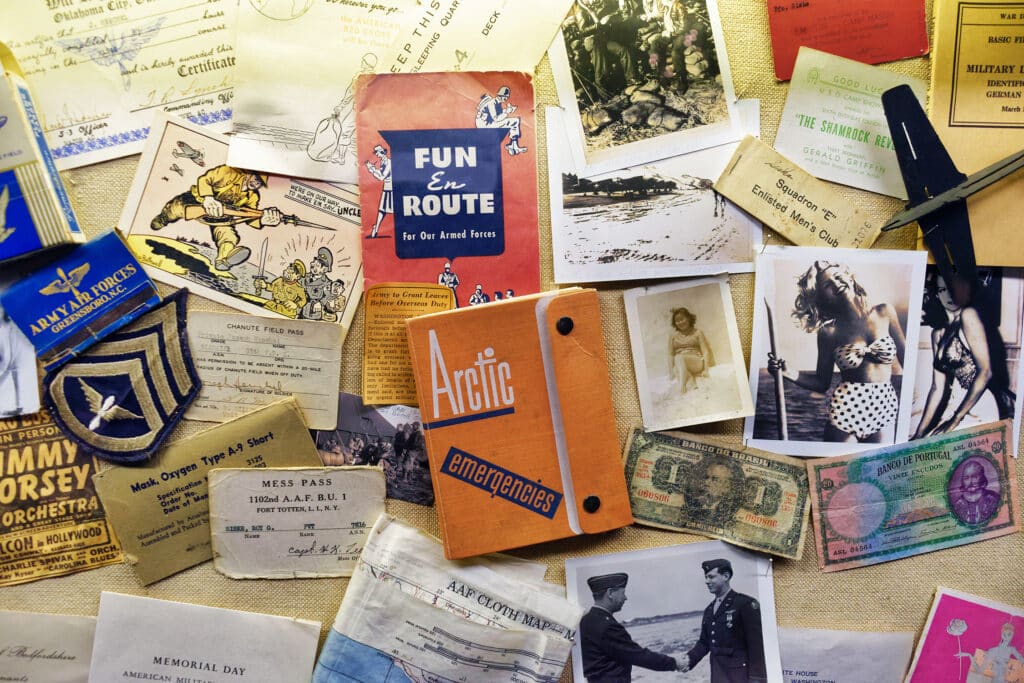Conflict and combat are as old as the story of man. To engage, man needed weapons to attack, and armor in various forms to protect himself. The result is centuries of military artifacts dating back to antiquity that tell the history and bear the scars of the hard-fought battles of their time.
Militaria is defined as artifacts or replicas of war, collected for their historical significance. Such antiques include firearms, swords, sabers, knives, bayonets, helmets powder horns, and other weaponry, as well as uniforms, military orders, ephemera, and decorations and insignia. While this is truly a global collectibles segment, with back-stories that reflect centuries of culture and conflict around the world, in this issue we focus on the objects and stories reflecting America’s military history, from the Revolutionary War through World War II.
Militaria aficionados typically start collecting because a parent or grandparent served in the military, although what they collect and where their collection goes from there is as diverse as the wars, weapons, and trappings of battle that capture their interest.
The most sought-after pieces of militaria are those that can be traced back to a specific serviceperson. Often, these artifacts are unearthed after being stored away in attics and basements for decades, likely found and opened, or unfolded, for the first time since being packed away after a soldier or sailor returned home from war.
Collectors of militaria love to know the story of the soldier who owned the piece. When the person who possessed the item is known, dealers and collectors refer to this as “identified.” Identified artifacts with verifiable histories often command premium prices.
Focusing on an individual is one popular and interesting way to build a militaria and firearms collection. Typically seeded with found items from an individual’s period of service, or initial investment piece, the collection can then be expanded by researching the serviceperson’s background, military service record, and contributions by including such items as photographs, letters from the front, and items related to the person’s rank, battles, and war era. These types of collections and objects tell a story built around a real and specific individual and their service experience.
Other collections focus on military medals, historical weapons (sabers, swords, firearms), military uniforms (helmets, uniforms, belt buckles), and war ephemera (newspaper clippings, posters, photographs, diaries, comic books). Some people collect a bit of everything while others focus on just one equipment type and collect a wide variety, or focus their collection around a specific war and or nation. The ultimate specialists are those who collect only certain items from certain nations, sometimes even specific vital pieces of an item. For example, there are specialists who collect and study only United States silver and bronze star awards and their World War II recipients, or the embroidered insignia that were stitched on German uniforms and caps during the same time period.
Some people might specialize even further within one of these groups. Such “super specialists” are valuable to the antique collecting community because they can often tell at a glance when something was made and maybe even which company manufactured it. For expensive or popular items this is an important resource.
Like many collectors, militaria buffs want to display their finds to share with others. For those that collect uniforms and gear, mannequins (torso and full size) provide an opportunity to display a fully outfitted soldier, from helmet to boots, rather than a collection of objects. Mancaves designed as bunkers provide an opportunity to decorate with flags and photos, and showcase antique firearms and other weapons of war on mounted displays. Riker-mounts, museum cases, and drawer cases are ideal for displaying, storing, and hanging such items as medals, patches, emblems and ribbons.
Militaria items can be found at flea markets, specialty auctions, antique firearms shows, on the internet, and through specialty dealers and fellow collectors. As with all collectibles, pricing varies based on age, rarity, provenance, significance, condition, and authentication. Forgeries, misrepresentations (“hyped” items), and reproductions are rampant, which is why doing your homework and only working with reputable dealers and auction houses is so important when adding an investment piece to your collection. For a look at what some prized Militaria items are going for these days at auction, turn to Joel Bohy’s article in our November issue.
In this issue we also explore the practical beauty of powder horns during the Revolutionary War, the use of Coleman stoves by soldiers in World War II, the history and meaning behind military buttons and the technology behind hand-forged swords, among other topics. Our goal is to share the history and stories behind the objects we collect, and honor the brave men and women who took them into battle in defense of our country. We thank them for their service.





Related posts: